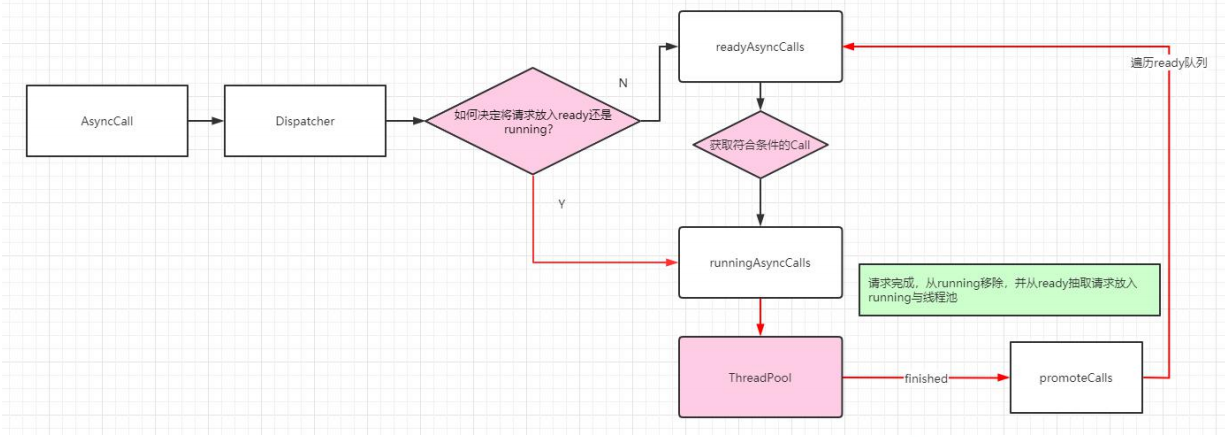Android源码解读——OkHttp开源框架
OkHttp介绍
- 支持HTTP/2并允许对同一主机的所有请求共享一个套接字
- 通过连接池,减少了请求延迟
- 默认通过GZip压缩数据
- 响应缓存,避免了重复请求的网络
- 请求失败自动重试主机的其他ip,自动重定向
使用方法(get/post)

调用流程
- 分发器:内部维护队列与线程池,完成请求调配;
- 拦截器:五大默认拦截器完成整个请求过程。

- 创建OkHttpClient(可以new,也可以通过build构建)
- 创建一个Request请求
- 将Request请求打包成一个Call(任务)
- 选择请求方式(同步 or 异步)
- 通过OkHttpClient的dispatcher对Call进行分发
- Interceptors进行拦截
- 完成请求,接收Response数据
分发器:异步请求工作流程(Call+Dispatcher)
流程图如下:

结合源码具体分析,由Call开始。当我们将Request打包成Call的时候,实际上是OkHttp内部直接new了一个RealCall 然后返回Call(RealCall实现了Call接口)。
static RealCall newRealCall(OkHttpClient client, Request originalRequest, boolean forWebSocket) { // Safely publish the Call instance to the EventListener. RealCall call = new RealCall(client, originalRequest, forWebSocket); call.eventListener = client.eventListenerFactory().create(call); return call; }
因此我们得到的call实际上就是RealCall,所以在我们要完成同步请求(execute)或者异步请求(enqueue)时,直接就在RealCall身上去调用execute()方法或者enqueue()方法。
异步请求RealCall.enqueue
@Override public void enqueue(Callback responseCallback) { synchronized (this) { if (executed) throw new IllegalStateException("Already Executed"); executed = true; } captureCallStackTrace(); eventListener.callStart(this); client.dispatcher().enqueue(new AsyncCall(responseCallback)); }
- 首先该方法需要我们提供一个callback,这个callback就是通知我们请求成功或者失败的一个接口
- 然后会进过一个if判断,这个if判断表示的是,如果call调用过了execute()方法或者enqueue()方法,那么再次调用的时候回直接报异常
- 接下来是内部的一些回调和我们自己可以注册的一些监听
- 最重要的是最后一行代码(client即OkHttpClient):调用OkHttpClient的dispatcher的enqueue方法,把Call打包成一个任务传进去
这个方法就是进行任务分发,看任务是分发到running队列还是ready队列,running队列就是执行队列,ready队列就是等待执行队列
synchronized void enqueue(AsyncCall call) {
/* 判断执行队列中的任务是否超过64个 */ /* 判断执行队列中的指向同一域名的任务是否超过5个 */ if (runningAsyncCalls.size() < maxRequests && runningCallsForHost(call) < maxRequestsPerHost) {
/* 将任务添加至running队列 */ runningAsyncCalls.add(call);
/* 分配线程池,执行任务 */ executorService().execute(call); } else {
/* 将任务分配至ready队列 */ readyAsyncCalls.add(call); } }
64与5这两个数是OkHttp规定的,意思是:例如我们APP同时访问百度、阿里、腾讯等N个不同域名服务器,最多同时执行的任务不能超过64个,否则手机可能吃不消,这是为了我们手机性能所考虑的,而当我们的running列表访问百度的任务已经到达5个的时候,再来执行访问百度的任务,即使总任务没超过64个,OkHttp也会将该任务放入ready队列而不是放进running队列,目的就是防止服务器过载,试想如果没有这个限定,每台手机都可以同时访问服务器100次,那100台手机是多少?1000呢?
执行任务
executorService().execute(call); call是 AsyncCall 而 AsyncCall 继承自NamedRunnable类,在NamedRunnable类实现了Runnable接口,并重写了run方法,而run方法里面执行的是一个抽象函数execute,所以执行任务的代码实际上就是在AsyncCall.execute()方法里面
@Override protected void execute() { boolean signalledCallback = false; try { Response response = getResponseWithInterceptorChain(); if (retryAndFollowUpInterceptor.isCanceled()) { signalledCallback = true; responseCallback.onFailure(RealCall.this, new IOException("Canceled")); } else { signalledCallback = true; responseCallback.onResponse(RealCall.this, response); } } catch (IOException e) { if (signalledCallback) { // Do not signal the callback twice! Platform.get().log(INFO, "Callback failure for " + toLoggableString(), e); } else { eventListener.callFailed(RealCall.this, e); responseCallback.onFailure(RealCall.this, e); } } finally { client.dispatcher().finished(this); } }
这段代码是try...catch...finally 所以finally里面的代码必定会执行,因此我们可以知道client.dispatcher().finished(this);必定会执行
/** Used by {@code AsyncCall#run} to signal completion. */ void finished(AsyncCall call) { finished(runningAsyncCalls, call, true); } /** Used by {@code Call#execute} to signal completion. */ void finished(RealCall call) { finished(runningSyncCalls, call, false); } private <T> void finished(Deque<T> calls, T call, boolean promoteCalls) { int runningCallsCount; Runnable idleCallback; synchronized (this) { if (!calls.remove(call)) throw new AssertionError("Call wasn't in-flight!"); if (promoteCalls) promoteCalls(); runningCallsCount = runningCallsCount(); idleCallback = this.idleCallback; } if (runningCallsCount == 0 && idleCallback != null) { idleCallback.run(); } }
finished方法进行了重载,我们在finally里面调用的是第一个finished方法,实际上执行的是第三个finished方法,切带了两个参数runningAsyncCalls和true
runningAsyncCalls表示running队列,首先会将传过来的call,也就是刚刚执行的任务从队列里面remove。因此可以得到不管访问服务器成功与否,都会执行finally,那么也必然会把任务从running列表里面删除
其次promoteCalls传过来的是true,所以会执行promoteCalls()方法,这个方法就是把任务从ready列表提取到running列表
private void promoteCalls() { if (runningAsyncCalls.size() >= maxRequests) return; // Already running max capacity. if (readyAsyncCalls.isEmpty()) return; // No ready calls to promote. for (Iterator<AsyncCall> i = readyAsyncCalls.iterator(); i.hasNext(); ) { AsyncCall call = i.next(); if (runningCallsForHost(call) < maxRequestsPerHost) { i.remove(); runningAsyncCalls.add(call); executorService().execute(call); } if (runningAsyncCalls.size() >= maxRequests) return; // Reached max capacity. } }
看见了几个熟悉的判断没?首先会判断是否超过64,其次判断ready队列是否为空,在遍历里面判断同一个域名任务是否超过5个,最后把任务从ready列表提取到running列表,分配线程执行
- Q1:为什么还要判断是否大于64?在进入这个方法之前不是已经remove掉了刚刚执行完的任务吗?那么最多也是63个,为什么还需要判断?
- A1:因为在执行完任务remove之后,很有可能有新任务会参与进来,当新任务参与进来的时候首先会判断running队列是否超过64,那么此时running队列在remove了一个任务之后是63,此时新任务会直接进入running队列,而不会进入ready队列,那么此时的running队列达到64个任务,已满。如果这里我们不进行判断直接添加进去,那么就会变成65个任务执行了。
- Q2:为什么需要遍历?直接取一个任务出来不行吗?
- A2:遍历的目的是为了判断该任务的访问域名,只要是用于判断同一域名下不能超过5个限制。
- Q3:是优先级队列吗?
- A3:不是。是双端队列,不过似乎用不到双端队列的特性。
同步请求RealCall.execute()
@Override public Response execute() throws IOException { ...
try { client.dispatcher().executed(this); Response result = getResponseWithInterceptorChain(); if (result == null) throw new IOException("Canceled"); return result; } catch (IOException e) { eventListener.callFailed(this, e); throw e; } finally { client.dispatcher().finished(this); } }
通过代码client.dispatcher().executed(this);执行到executed方法。
synchronized void executed(RealCall call) { runningSyncCalls.add(call); }
可以看到这个方法没有做其他的事情,只是把任务添加到了一个队列,这个队列并没有类似异步请求的64和5的限制,这个队列目的是为了方便我们做统计。
因此整个OkHttp的任务队列可以分为三个:
- ready队列,异步等待执行的任务队列
- runningAsync队列,异步正在执行的任务队列
- runningSync队列,同步任务队列
而Response result = getResponseWithInterceptorChain(); 则是真正执行同步请求的代码。
可以看到这里并没有用到线程池,也没有开启新线程去执行任务,因此这里用的是同步请求的方式。
线程池
executorService = new ThreadPoolExecutor(0, Integer.MAX_VALUE, 60, TimeUnit.SECONDS, new SynchronousQueue<Runnable>(), Util.threadFactory("OkHttp Dispatcher", false));
在OkHttp里new了一个线程池,这个线程池的特性是具有最大吞吐量、高并发的一个线程池,具体原因可以去参考我的一篇关于线程池的文章。
拦截器(Interceptor)
getResponseWithInterceptorChain()方法
Response getResponseWithInterceptorChain() throws IOException { // Build a full stack of interceptors. List<Interceptor> interceptors = new ArrayList<>(); // 自定义拦截器 interceptors.addAll(client.interceptors()); // 重试拦截器在交出(交给下一个拦截器)之前,负责判断用户是否取消了请求;在获得了结果之后 ,会根据响应码判断是否需要重定向,如果满足条件那么就会重启执行所有拦截器 interceptors.add(retryAndFollowUpInterceptor); // 桥接拦截器在交出之前,负责将HTTP协议必备的请求头加入其中(如:Host)并添加一些默认的 行为(如:GZIP压缩);在获得了结果后,调用保存cookie接口并解析GZIP数据。 interceptors.add(new BridgeInterceptor(client.cookieJar())); // 缓存拦截器,交出之前读取并判断是否使用缓存;获得结果后判断是否缓存。 interceptors.add(new CacheInterceptor(client.internalCache())); // 连接拦截器在交出之前,负责找到或者新建一个连接,并获得对应的socket流;在获得结果后 不进行额外的处理。 interceptors.add(new ConnectInterceptor(client)); // 如果不是websocket请求,自定义的拦截器 if (!forWebSocket) { interceptors.addAll(client.networkInterceptors()); } // 请求服务器拦截器进行真正的与服务器的通信,向服务器发送数据,解析读取的响应数据。 interceptors.add(new CallServerInterceptor(forWebSocket)); Interceptor.Chain chain = new RealInterceptorChain(interceptors, null, null, null, 0, originalRequest, this, eventListener, client.connectTimeoutMillis(), client.readTimeoutMillis(), client.writeTimeoutMillis()); return chain.proceed(originalRequest); }




